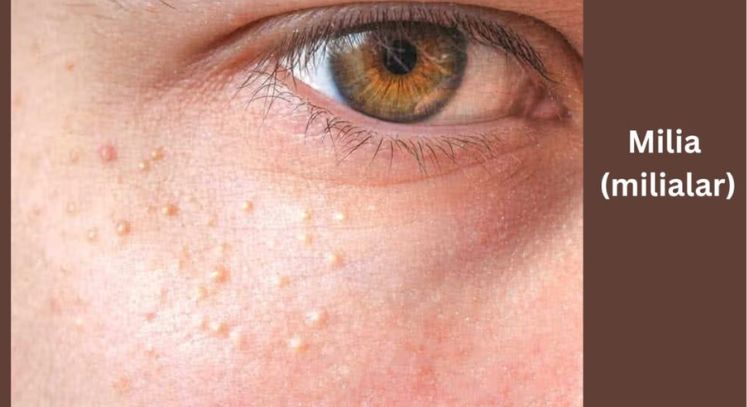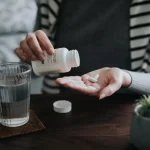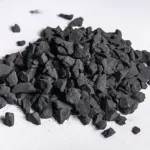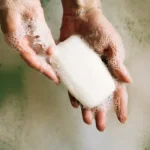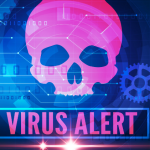Milialar are tiny cysts that form under the skin’s surface and on the face. One cyst is a milium, but for more than one cyst, the word is milia. Milialar appears as white- or yellow-colored bumps, but on darker skin tones,it exists in a faint blue color.
Milialar is not an acne form but they appear on the skin in the form of tiny bumps. They might develop in response to something else, like damage to the skin
Causes
Here are the crucial causes of miliaria or “heat rash”:
Skin Friction
Tight garments, snug waistbands, helmets, braces on teeth or limbs, bedsheets, and medical devices like oxygen tubing or CPAP masks can create pressure points and friction that blocks sweat ducts.
Dehydration
In some instances, inadequate fluid and electrolyte intake can contribute to impaired sweating. When the body lacks sufficient water and salts, the normal flow of perspiration is disrupted, leading to backups.
Lack of Acclimatization
People who are not used to particular hot settings like new military recruits or those who rapidly travel to tropical climates have higher incidences until their bodies adjust sweat production.
Infants and Early Childhood
Babies and young children are at increased risk as their sweat glands are still maturing, and they have less capacity to regulate body temperature themselves by controlling clothing layers.
While rarer, certain skin disorders, fungal infections, and chronic conditions like diabetes, thyroid disorders, and heart disease can also influence sweating and predispose someone to miliaria outbreaks. Paying attention to visible skin changes and being aware of risk factors enables quicker response.
Symptoms
Here are some symptoms:
- Prickling, itching, or heating sensations in areas of skin where rash develops. This discomfort indicates obstruction of sweat glands near the skin’s surface.
- Possible calm, flat patches of skin next to small raised dots as deeper sweat ducts remain unblocked while superficial ones trap perspiration. This gives a speckled, uneven appearance.
- In severe cases, extensive areas of rash that have started to weep fluid from cracked bumps or show signs of potential skin infection such as yellow crust or pus.
- Babies with miliaria who are extra fussy, run a fever, or exhibit breathing issues require immediate medical care to stabilize temperature, hydration, and electrolyte balances.
Carefully observing the intensity, location, and types of skin changes helps distinguish heat rash from allergic reactions or other skin conditions. Seeking early diagnosis ensures proper treatment.
Read: EXPERT ADVICE FOR CLEARING CLOSED COMEDONES
Precautions
Here are some significant precautions to prevent heat rash:
- Wear loose fabrics – Tight clothing traps heat and sweat. So, hoose lightweight, moisture-wicking fabrics.
- Avoid overheating environments – Take regular breaks in cooler, drier areas if you need warm and humid.
- Use mild skin care products – Harsh ingredients found in some products may worsen blocked pores and irritation.
- Stay well hydrated – Drink enough fluids so sweat flows normally instead of pooling within ducts. However, take care not to over-hydrate.
- Protect babies from direct sun – Use shade, loose covers, and limit sun exposure to keep infants’ delicate skin from excess heating.
- Allow existing rash to heal – Avoid rubbing or scraping bumps which can lead to infection. Let rash run its course once formed.
- See a doctor for severe cases – If rash spreads extensively, persists beyond a few days, or shows signs of infection, seek medical treatment.
Following these precautions where possible can reduce the likelihood of uncomfortable miliaria outbreaks. Be extra mindful when sweating is heaviest or skin is most vulnerable.
Treatment
Most cases of miliaria clear up on their own once the source of friction or sweat blocking is removed. But when bumps are severe or persistent, medical treatment may help provide relief.
- Medicated Powders: Over-the-counter powders containing menthol and zinc oxide can help dry excess moisture and reduce irritation. These are often used for baby heat rashes.
- Topical Steroids: The tropical steriods, like hydrocortisone creams cab calm stubborn areas of inflammation,
- Oral Antihistamines: Allergy medications like diphenhydramine (Benadryl) have anti-itch effects and can treat discomfort systemically for quick relief. Caution is needed when giving these to infants.
- IV Fluids and Electrolyte Therapy: In severe cases where infants or vulnerable individuals have disrupted sweat function leading to dangerous fluid or salt imbalance, IV hydration and electrolyte correction in hospital stabilizes body chemistry.
- Wet Wrap Therapy: For weeping, inflamed rashes not responding to other measures, wet cotton wraps covered by dry bandages help drain fluid while calming skin.
When to See a Doctor
In most cases miliaria resolves on its own. But if rash spreads, lasts more than 3-4 days, or shows signs of skin infection, seek medical attention. Receiving accurate diagnosis and treatment helps minimize scarring. Monitor babies with miliaria carefully and call a pediatrician if fever, fussiness or breathing issues occur.
Conclusion
In conclusion, miliaria or “heat rash” is a common skin condition, which occurs due to blocked sweat glands trapping perspiration under the skin. It results in small, red, itchy bumps that occurr in areas prone to sweating and friction. While typically minor, miliaria can cause pronounced discomfort.
You can cure this ailment by preventing sweating and skin irretation. You can also prevent it by wearing moisture-wicking clothing, resting, cleansing skin, and maintaining hydration. Moreover, the use of drying powders, anti-inflammatory creams, antihistamines for, antifungals, and wet wrap therapy can treat this ailment. Though often clearing up on its own, severe or worsening rash warrants medical attention to rule out infection and minimize scarring..
FAQs
Is it OK to pop heat rash blisters?
No, dermatologists advise against popping miliaria blisters. This can increase inflammation and the risk of pushing bacteria deeper into pores, causing infection. Allow bumps to heal naturally. Cleanse skin gently and use medicated powders to dry them out.
Can I prevent miliaria with antiperspirant?
Using clinical-strength antiperspirants is generally not recommended to treat existing rash or prevent miliaria long-term. These products contain harsh ingredients to obstruct sweat ducts, which can further inflame already irritated areas.
Does Txcessive Tater can Treat heat rash?
Drinking excess water alone will not make miliaria bumps disappear faster once they form. Moisture gets trapped under blocked pores regardless of hydration level. Reducing friction, allowing ventilation, and using drying agents offer more direct relief.
Can babies go outside if they have heat rash?
It’s OK to take babies outdoors if they have mild heat rash, but sun exposure should be very limited. Seek shade, avoid direct sunlight on skin, and keep infants lightly dressed to prevent overheating and worsening of miliaria. If rash persists longer than a few days or causes fever, call your pediatrician.

